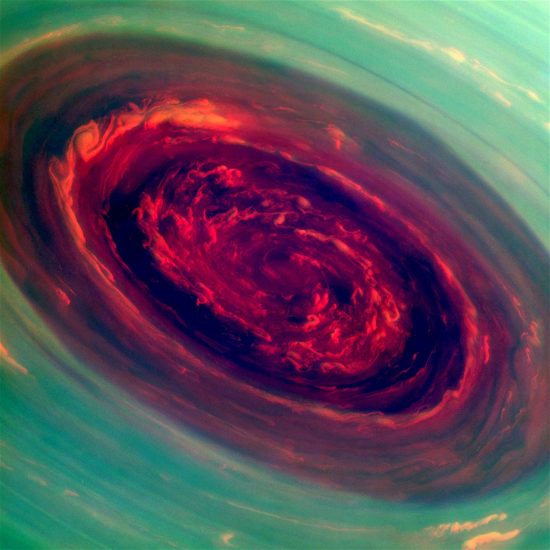


A giant “hurricane” on Saturn. Credit: NASA’s Goddard Space Flight Center/NASA/JPL-Caltech. Click to enlarge.
Jul 17, 2017
Electricity influences Saturn’s environment.
The picture at the top of the page could be mistaken for recent images of Jupiter’s Great Red Spot. However, the swirling vortex is actually located in the center of Saturn’s vast, hexagonal north polar formation.
Hexagons and other polygons can sometimes occur in hurricanes, so astrophysicists believe that fluid dynamics can explain what they call a “mysterious” phenomenon. In 2010 physicists from Oxford University spun a 30-liter cylinder of water, with a ring of viscous green dye inside spinning faster than the cylinder. Their thinking was that a “jet stream” analogue could provide a plausible description of what is happening on Saturn if several factors are ignored.
First, they did not produce concentric rings around the hexagon, each with different temperatures. Second, Saturn’s poles are hotter than theories predict. Third, there are aurorae at the poles. Fourth, there is electric charge flow connecting Saturn’s poles to its family of moons. Additionally, the winds in the polar vortex are four times faster than any hurricane, nor does it move around. Such kinetic experiments are insufficient in scope, since electrical effects are not considered. Perhaps the kinetic model should be stood on its head: the polygons in hurricanes should be reevaluated in the light of electrical theories.
Electricity flowing through plasmas can create a central column surrounded by concentric cylinders, as retired Professor of Electrical Engineering, Dr. Donald Scott proved. Filamentary structures form evenly spaced vortices surrounding the column. As the filaments rotate around one another, a hexagonal cross-section forms inside.
In an Electric Universe, electricity moves along charged Birkeland currents connecting the Sun with its planets. Energy flows most strongly into the giant gas planets because their charge differential with the Sun is greater than that of their smaller, rocky cousins. The electric Sun is what drives so-called “meteorological” activity on Saturn.
Many years ago, planetary scientists admitted that Saturn’s polar hurricane cannot be explained:
“The driving forces behind the motion, and indeed the global motion of Saturn’s atmosphere, still need to be understood.”
Their lack understanding is because electrodynamic circuits initiate “anomalous heating” on Saturn. Not only Saturn, but the other gas planets, as well. Jupiter and Neptune display hot poles. The double-eye vortex on Venus, along with the hot poles on Enceladus, Titan and Io will also benefit from acknowledging the principle tenets of an Electric Universe.
Stephen Smith